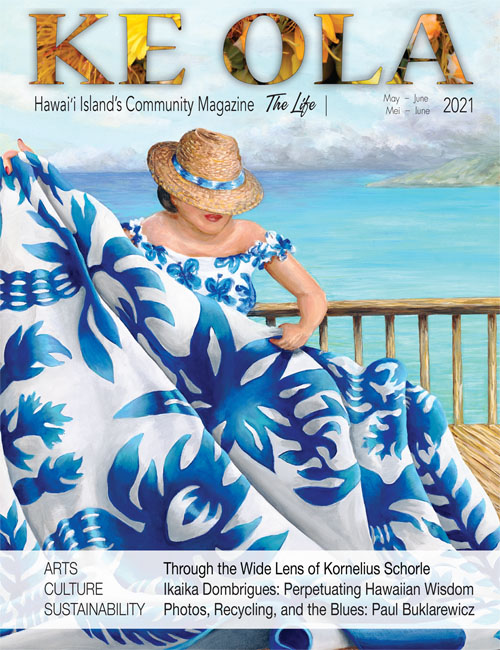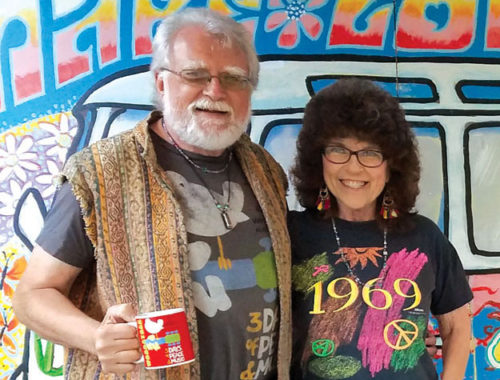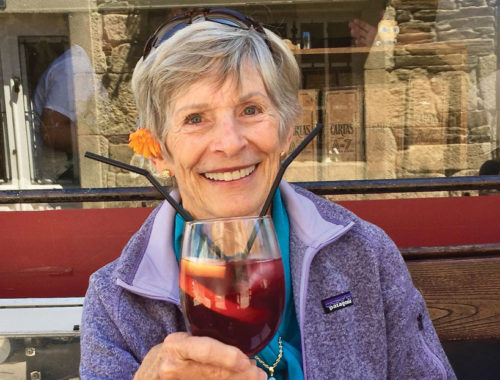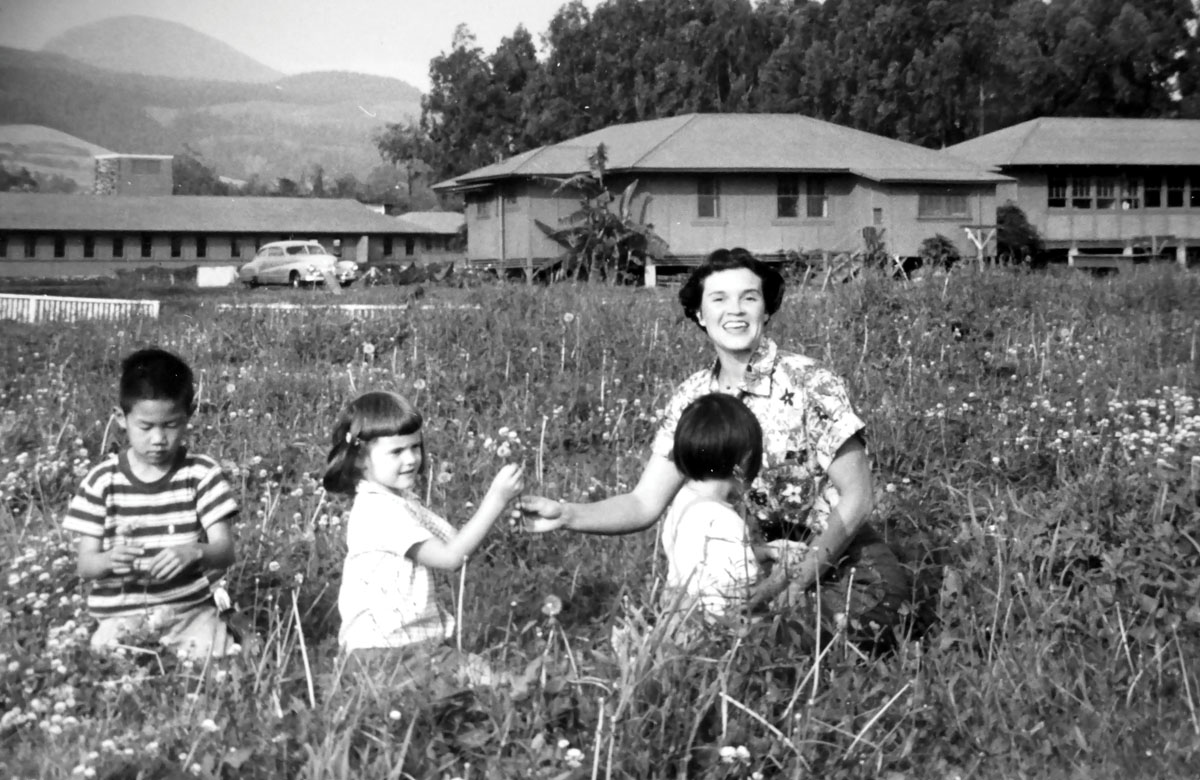
St. James’ Circle: A Hub of Resilience
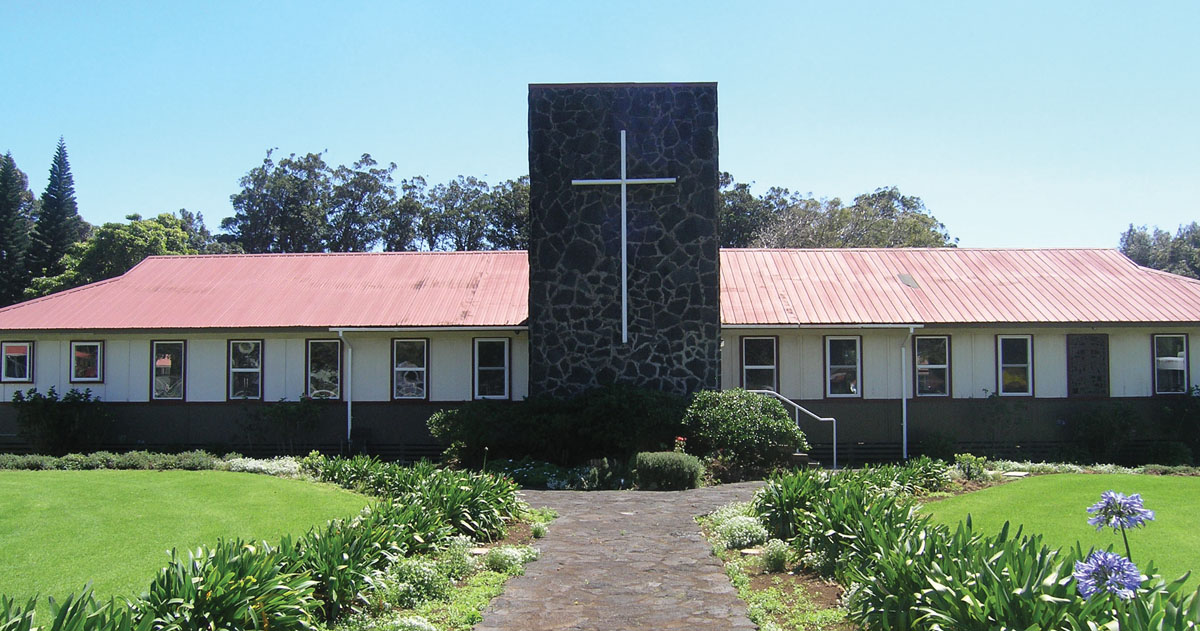
By Jan Wizinowich
It’s Thursday morning and St. James’ Circle in Waimea is a humming hive of activity. The church kitchen is abuzz with volunteers cheerfully chopping ingredients, then cooking and filling pans with the evening’s weekly community meal. Another group of volunteers readies the St. James’ Thrift Store for business. Soon a yoga class will be assembling at Waimea Yoga, Waimea Country School students will be dashing across the grass for their daily physical education class, and little ones will be gathering at Small World Preschool.
The Circle in the Making
St. James’ Circle evolved from a small group of dedicated worshipers who met in various homes, to a circle of buildings forming a synergy of positivity. With the arrival of Reverend Frank Merrill in 1911, plans for the new church, dubbed St. James the Great, quickly got underway with the order of a church building from American Portable House Company of Seattle.
With the building on the way, a search for a place to put it began. That’s where Mabel Beckley, great-granddaughter of John Palmer Parker, came in. She approached Parker Ranch manager AW Carter, who granted them a 50-by-100-foot plot in the area of the old Waimea Courthouse.
In December 1912, church members celebrated their first Christmas Eve service and provided the first community Christmas celebration: “On Christmas Eve, members of St. James’, Mrs. Henry Beckley, her sister Miss Maud Woods, and Miss Nora Keawe, began a tradition at the town hall, part of which is still continued in Waimea today; they provided a Christmas tree and a Santa Claus to distribute gifts for the children of the town.”*
In 1930, the Sharritt and Arioli families donated the three acres of rough pastureland bounded by Waikoloa Stream that was to become St. James’ Circle and “the chapel was braced, lifted onto a stone sledge, and pulled by two Percheron horses to the new site.”*
The next addition was a graveyard, where Samuel Parker Jr., son of Samuel Parker and Panana Napela, was interred in 1934, followed four years later by original church member Carolyn Sharratt. Eventually the graveyard was bounded by low rock walls and bordered with ‘ōhia and jacaranda trees.
Sometime in the 1930s two or three small houses were connected together and placed in the northwest corner of the property and eventually became the vicar’s residence, which is the current church office. The rest of the buildings of St. James’ Circle originated from World War II and the educational needs of the community.
When the 2nd Division Marines arrived in Waimea from one of the bloodiest battles of World War II, they were in dire need of a hospital and took over Waimea School and Waimea Hotel, leaving students to attend classes at various alternative locations and homes.
Waimea needed a school and in 1943 the Seabees got busy constructing the canec buildings that are still standing today. Canec was a building material made from bagasse, a fibrous material that is the byproduct of sugarcane processing. From 1943 to 1945, with the exception of the commandant’s house (southwest corner), Waimea School students attended classes in those buildings.

The Hawai‘i Episcopal Academy and the Roots of Hawai‘i Preparatory Academy
When the war ended, the buildings were left empty and the circle was eerily quiet, but not for long; a seed had been planted and when Bishop Kennedy observed the empty buildings, he saw them as a way to meet a community need and began to make plans for a school. By the fall of 1949, working with local businessmen, Bishop Kennedy, and St. James’ Church, they opened the Hawai‘i Episcopal Academy (HEA).
Interviewed for this story, Dave Coon (teacher 1950–1951, mission vicar 1954–1957) recalls arriving in the summer of 1950. He was immediately put to work in what later became the James Spencer building (northeast corner). “When I arrived in the summer of 1950, the Reverend Paul Savanack was the interim headmaster. We looked at the building and walked inside and it was totally bare. Empty. And he said, ‘Here’s a lot of lumber over here, make a library,’” remembers Dave.
The buildings now house students, teachers, and classrooms. Moving around the circle starting from the James Spencer building, you come to the building that now holds the Thrift Store. “There were three of us teachers at the road end of it. The rest of the building was a dormitory and at the end was a room for another teacher,” says Dave.
Then, moving south, “the Waimea Country School building was a dormitory for girls and a teacher, who more or less ran the building. The Small World Preschool building was the kitchen and dining room, and the whole Waimea Yoga building was classrooms,” said Dave.
James Taylor arrived in 1954 to begin a 20-year career as headmaster. The original chapel was still standing just west of the current church building and served as the headmaster’s office. But the American Portable House Company of Seattle hadn’t figured on the ka makani winds and, sometime in the early 1960s, the chapel had to be disassembled and removed.
The upper campus of Hawai‘i Preparatory Academy opened in 1961 and once again St. James’ Circle was reconfigured. The elementary classes began by Lynn Taylor in 1958 now expanded to fill the space and along with elementary school classes, the circle continued to provide housing for faculty.
By then, the 20-year-old canec buildings were beginning to show their age. Howard Hall and his wife, Pat, arrived in 1964 to begin a 40-year teaching career at HPA and lived in the north end of the Waimea Country School building. “The canec walls were so waterlogged that by the end of the year, the tacks holding Pat’s artwork rusted through,” remembers Howard.
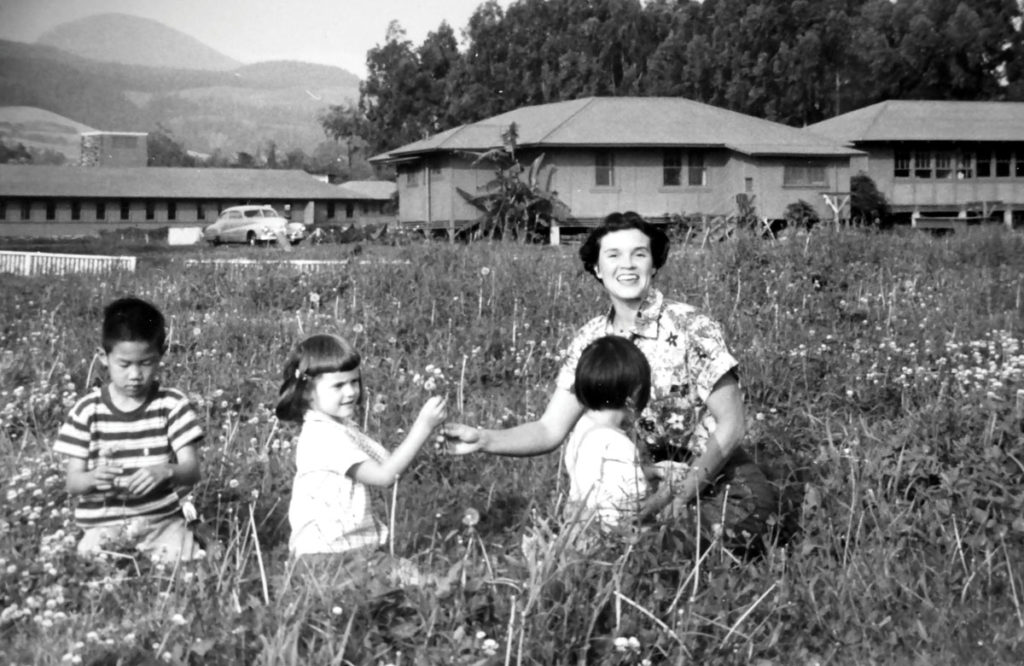
Parker Ranch Connections
Richard Smart had always had a special relationship with St. James’. Mrs. Mabel Beckley and her sister, Maud Woods, two of the original members, were his cousins. Also Fr. Merrill had married Richard’s parents in 1912, baptized Richard in 1913, and buried Richard’s mother in 1914.
In 1950, Richard decided to present the church with a new building and by mid-October 1950, ground was broken by James Kurakawa and his cadre of ranch carpenters (which included church member Dempsey Harada) for a one-story, 100-by-24-foot redwood building, “to take care of the social as well as the spiritual needs of the Mission.”*
While the new church was being constructed, Dave Coon loaded HEA students, ‘ō‘ō bars, and other implements onto a flatbed truck and headed up Saddle Road to Humu‘ula to collect pahoehoe, which was used for the front walkways and the bell tower facing, “installed by a crew directed by faithful vestry member James Spencer.”* The first service in the new church took place in March 1951 with cross-sections of the community, in the spirit of inclusion.

St. James’ Circle Growing Community Connections
In the spirit of aloha, the congregation of St. James’ Church has opened their hearts beyond the sanctuary doors and view the buildings and resources of St. James’ Circle as something to be shared. The church has become a meeting place for support groups, Boy Scouts, and veterans and, until the pandemic, a place for Sunday afternoon worship conducted by the Marshallese ‘ohana.
“Outreach is key to who we are today and the seeds that were planted years ago have taken root and are blossoming now,” says Reverend David Stout, in his 10th year as St. James’ rector.
The Thursday community meal, a joyous affair, began in 2016. “The parish ‘ohana wanted a feeding ministry. They wanted to try it and see who came. Sue Dela Cruz and Tim Bostock took it on and it turned into a party every Thursday in the pavilion with live music. People came and shared a meal. A festive event that fed both body and soul,” says Reverend David.
With the pandemic, the meal program has both expanded and contracted. More than 600 meals are now distributed in a drive-through on Thursdays from 4:30 to 6:00. “People in the drive-through are asking when we can gather again. The meal is really the greatest event I’ve ever promoted,” says Tim, who is a professional event promoter.
The gathering place, Savanack Pavilion (western edge), donated in 1973 by Julia and Tommy Rodenhurst, started out as a place for the annual fundraising plant sale. It now serves as a support kitchen for the community meal, mostly prepared in the church building, but there are plans to “wrap the whole operation into one with a fully commercial kitchen and share it with a number of people,” says Tim.
St. James’ Circle has been given the title “Hub of Resilience” by the granting organization Vibrant Hawai‘i. Through their support, St. James’ sponsors 175 meals a week, prepared by Ippy’s Restaurant and delivered to kūpuna in the community.
“The property we’ve inherited is a great blessing. We are stewards of it in our time, to continue to be a place of worship, education, and community connections,” concluded Reverend David.
Mahalo nui for contributing to this story: Everette Knowles, Jo Pilz, Dave Coon, Jane Taylor, Tim Bostock, Reverend David Stout, Sue Dela Cruz, and Howard and Pat Hall. ❖
For more information: stjameshawaii.org
Story sources:
*Ke Akua Alaka‘i iā Kākou: St. James’ Episcopal Church centennial booklet
Waimea Gazette: Waimea Remembers Camp Tarawa by Gordon Bryson
